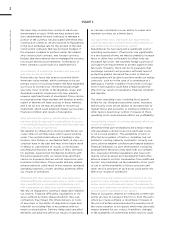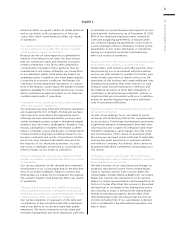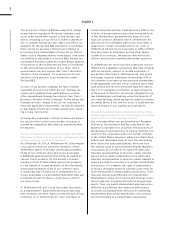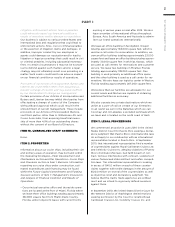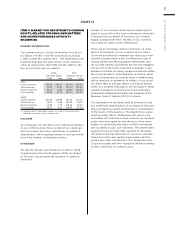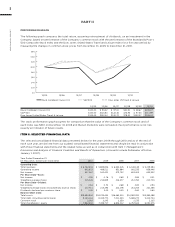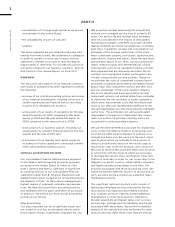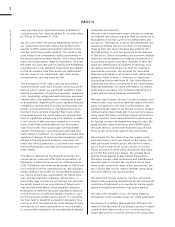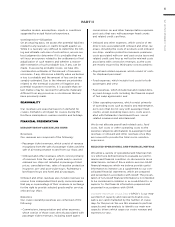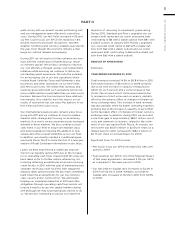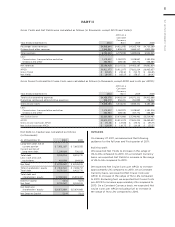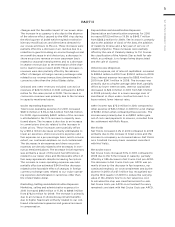Royal Caribbean Cruise Lines 2010 Annual Report Download - page 43
Download and view the complete annual report
Please find page 43 of the 2010 Royal Caribbean Cruise Lines annual report below. You can navigate through the pages in the report by either clicking on the pages listed below, or by using the keyword search tool below to find specific information within the annual report.
2010 ANNUAL REPORT 40
PART II
carrying value by a significant margin. Pullmantur’s
reporting unit’s fair value exceeded its carrying value
by 37% as of December 31, 2010.
We also performed the annual impairment review of
our trademarks and trade names during the fourth
quarter of 2010 using a discounted cash flow model
and the relief-from-royalty method. The royalty rate
used is based on comparable royalty agreements in
the tourism and hospitality industry. Since these trade-
marks and trade names relate to Pullmantur, we used
the same discount rate used in valuing the Pullmantur
reporting unit in our goodwill impairment test. Based
on the discounted cash flow model we determined
the fair value of our trademarks and trade names
exceeded their carrying value by 19%.
The estimation of fair value utilizing discounted
expected future cash flows includes numerous uncer-
tainties which require our significant judgment when
making assumptions of expected revenues, operating
costs, marketing, selling and administrative expenses,
interest rates, ship additions and retirements as well
as assumptions regarding the cruise vacation industry
competition and general economic and business con-
ditions, among other factors. The Spanish economy
has been more severely impacted than many other
economies around the world where we operate and
there is significant uncertainty as to whether or when
it will recover. If that economy weakens or recovers
more slowly than contemplated in our discounted
cash flow model, that could trigger an impairment
charge of Pullmantur’s goodwill and trademark and
trade names. In addition, it is reasonably possible that
significant changes to our projected operating results
utilized in the impairment analyses, especially our
future net yield assumptions, could lead to an impair-
ment of Pullmantur’s goodwill and trademark and
trade names.
The factors influencing the Spanish economy dis-
cussed above could also affect the recoverability of
Pullmantur’s deferred tax assets. As of December 31,
2010, Pullmantur had deferred tax assets of $35.6 mil-
lion resulting from net operating losses. We regularly
review deferred tax assets for recoverability based on
our history of earnings, expectations for future earn-
ings, and tax planning strategies. We believe it is
more likely than not that we will recover the deferred
tax assets based on our expectation of future earn-
ings and implementation of tax planning strategies.
Realization of deferred tax assets ultimately depends
on the existence of sufficient taxable income to sup-
port the amount of deferred tax assets. It is possible
we may need to establish a valuation allowance for a
portion or all of the deferred tax asset balance if future
earnings do not meet expectations or we are unable
to successfully implement our tax planning strategies.
Derivative Instruments
We enter into forward and swap contracts to manage
our interest rate exposure and to limit our exposure to
fluctuations in foreign currency exchange rates and
fuel prices. The majority of these instruments are des-
ignated as hedges and are recorded on the balance
sheet at their fair value. We have also entered into
fuel call options to limit our exposure to fluctuations
in fuel prices. These instruments are economic hedges
which are not designated as hedging instruments for
accounting purposes and thus, changes in their fair
value are immediately recognized in earnings. Our
derivative instruments are not held for trading or
speculative purposes. We account for derivative
financial instruments in accordance with authoritative
guidance. Refer to Note 2. Summary of Significant
Accounting Policies and Note 13. Fair Value Measure-
ments and Derivative Instruments to our consolidated
financial statements for more information on related
authoritative guidance, the Company’s hedging pro-
grams and derivative financial instruments.
We enter into foreign currency forward contracts and
interest rate, cross-currency and fuel swaps with third
party institutions in over-the-counter markets. We
estimate the fair value of our foreign currency forward
contracts and interest rate and cross-currency swaps
using expected future cash flows based on the instru-
ments’ contract terms and published forward curves
for foreign currency exchange and interest rates. We
apply present value techniques and LIBOR-based
discount rates to convert the expected future cash
flows to the current fair value of the instruments.
We estimate the fair value of our fuel swaps using
expected future cash flows based on the swaps’ con-
tract terms and forward prices. We derive forward
prices from forward fuel curves based on pricing
inputs provided by third-party institutions that trans-
act in the fuel indices we hedge. We validate these
pricing inputs against actual market transactions.
We apply present value techniques and LIBOR-based
discount rates to convert the expected future cash
flows to the current fair value of the instruments. We
also corroborate our fair value estimates using valua-
tions provided by our counterparties.
We determine the fair value for our fuel call options
based on the prevailing market price for the instruments
consisting of published price quotes for similar assets
based on recent transactions in an active market.
We adjust the valuation of our derivative financial
instruments to incorporate credit risk, when applicable.
We believe it is unlikely that materially different esti-
mates for the fair value of our foreign currency forward
contracts and interest rate, cross-currency and fuel
swaps and options would be derived from using other


